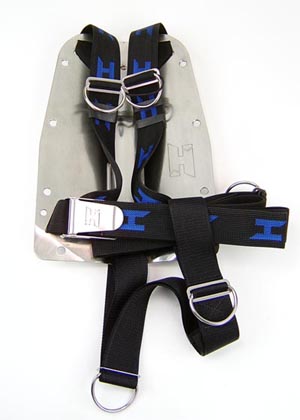Many awesome responses, thanks guys. I've been Googling for something like a walkthrough of the BP&W system like maybe a description of all of the components and the role they play but all I am finding is advertisements and they seem to be really selling one aspect or another of the product. Is there a non biased, education based place I can learn more about this type or hardware? I feel that if I gain more knowledge about the BP&W hardware and the role each piece plays I will have a better idea of what I am looking for.
And yes, I certainly plan to take lots of specialty courses to improve my skills and knowledge in different areas but I'd like a bit of a head start on the equipment learning.
I'm sure someone will post a link - or Tobin will chime in - shortly after I finish typing this...
Here's a link on configuring a BP/W rig: DIR-diver.com - Adjust the backplate
There's not many "components" to gain knowledge about, and their roles are pretty straightforward
- Backplate: tanks, wing, and harness attach to this; steel, aluminum, nylon/plastic versions available; all manufacturers offerings are largely more similar than different
-

- Wing: aircell to establish buoyancy via filling/dumping air via corrugated inflator hose. Single-tank and double-tank versions. There are some touted as being good for both singles/doubles... consensus seems to be they end up being less than ideal for either. Horseshoe and donut style available. Some have bolt-holes to attach to plate, others have slots for the cam band straps to be threaded through the wing and plate

- Harness: at it's simplest it's a single, continuous length of 2" webbing that comprises both shoulders and waist strap and allows diver to don the kit, while also accommodating several D-rings. A crotch strap is also part of the harness; this prevents the rig from riding up and is also used when diver is diving with a DPV (scooter)
- D-rings; typical recommendation is for 5; left shoulder, right shoulder, left hip, butt, and crotch.
- Buckle; typically metal, on the waist to secure the system; common to have a second buckle threaded on the right hip side to secure a canister light

- Weight system: your choice of weightbelt, harness, or integrated pockets; consideration should be given to amount of weight as well as placement of weight vis-a-vis trim considerations
- Cam-bands: two straps to attach a single tank to the system (doubles are attached via two bolts from the tank bands that go through two holes in the plate. Those holes are a standard distance apart across manufacturers) Some manufacturers require a tank adapter for attaching cam bands, some don't

- Storage pack: (optional) mounted to BP as way to store an SMB/lift bag

Put it all together and it looks something like this...

Other considerations:
- Some rigs have/need single-tank adapters (weighted or non-weighted)
- Some rigs have versions that are adjustable via additional buckles, straps, etc
- Some have ability to adjust a single, continuous strap
- Some rigs have padding on shoulder straps and/or backplate
- Some manufacturers offer different size plates; most people can manage with a regular/standard size
- There are all manner of attachable weights, weight pouches, pockets, accessories, etc available
Last edited:




